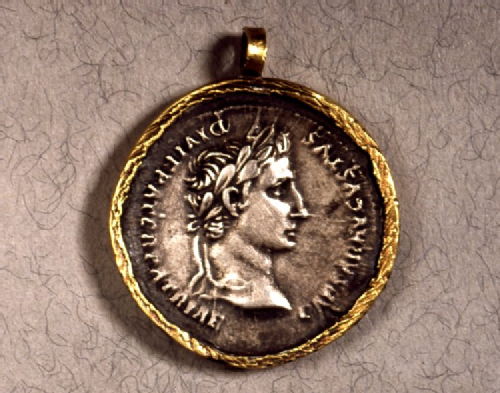The Emperor on a chain: Fashionable coins and questions of personal taste
 |
| Coin of Constantine used as a pendant |
This coin of Constantine dates from AD 330-331. It is typical of its type. The obverse displays an image of Constantine whilst the reverse praises the might of the Roman army; two soldiers holding spears flank military standards with the legend ‘GLORIA EXERCITVS’. The modern transformation of this particular coin into a piece of jewellery is not without its ancient precedent, and this has prompted me to investigate the afterlife of coinage in the Roman world.
It is widely accepted that coins are not simply important for their monetary value. To historians studying numismatics their imagery and legends provide evidence for things as diverse as architectural styles to hairstyles. Similarly, at the time of minting, coins held a value which extended further than what they could buy. The way that coins were used outside of the context of financial transactions can teach us valuable lessons about Roman society.
In Petronius’ Satyricon, the character Trimalchio is described as playing a board game with gold and silver denarii instead of the standard black and white counters. Trimalchio is more of a caricature than a character, so we should take scenes like this with a pinch of salt, but the author is here making a point about how the attitude of an individual towards coinage projects a social statement about their personal wealth. Trimalchio’s self-display tells his guests that he can, quite frankly, afford to play with his money. This can be extended to help us to understand why incorporating coinage into jewellery was a way of displaying your wealth and social status.
 |
|
Coin of Augustus used as a pendant © The Trustees of the British Museum |
But self-display was not the sole reason why an individual would choose to transform coins into jewellery. Nor can it simply be explained as a fashion, since fashions change and our evidence for coin pendants spans hundreds of years. A study of the iconography of the coins chosen for this purpose suggests that not just any coin would do. Generally our examples are drilled to allow a chain to pass through, or else a loop attached, and the location of this tells us which way the coin was intended to hang. In most cases the coin was orientated to display the obverse, most tellingly, the image of the emperor. For example, the coin pictured here is orientated to display the diademed profile of Augustus. This coin was minted in 2 BC and its use here celebrates the reign of Augustus. Thus one could argue that coin pendants projected a political as well as social message. The modern day transformation of the ‘Gloria Exercitvs’ coin follows this ancient precedent, but this time the choice was motivated by aesthetic value rather than a desire to make a political statement of allegiance to the emperor.
It is debatable whether the Roman jeweller was motivated by the aesthetic, political or social potential of coinage when they set about incorporating coins into jewellery. Clearly, these artefacts pose questions about the nature of Roman society and the nature of its value system; and since coin pendants remain popular today we could trick ourselves into believing that we are not so different from the Romans after all.
 This month's coin was chosen by Eve Bayram. Eve graduated from Warwick in 2014 with a degree in Classical Civilisation. While at Warwick Eve focused on the study of Latin literature, and her disseration was entitled 'Self-presentation in the Latin epistolary genre: Cicero, Seneca, Petrarch.' She is currently interning in the dictionaries department at Oxford University Press.
This month's coin was chosen by Eve Bayram. Eve graduated from Warwick in 2014 with a degree in Classical Civilisation. While at Warwick Eve focused on the study of Latin literature, and her disseration was entitled 'Self-presentation in the Latin epistolary genre: Cicero, Seneca, Petrarch.' She is currently interning in the dictionaries department at Oxford University Press.
 Clare Rowan
Clare Rowan


 Loading…
Loading…
Add a comment
You are not allowed to comment on this entry as it has restricted commenting permissions.